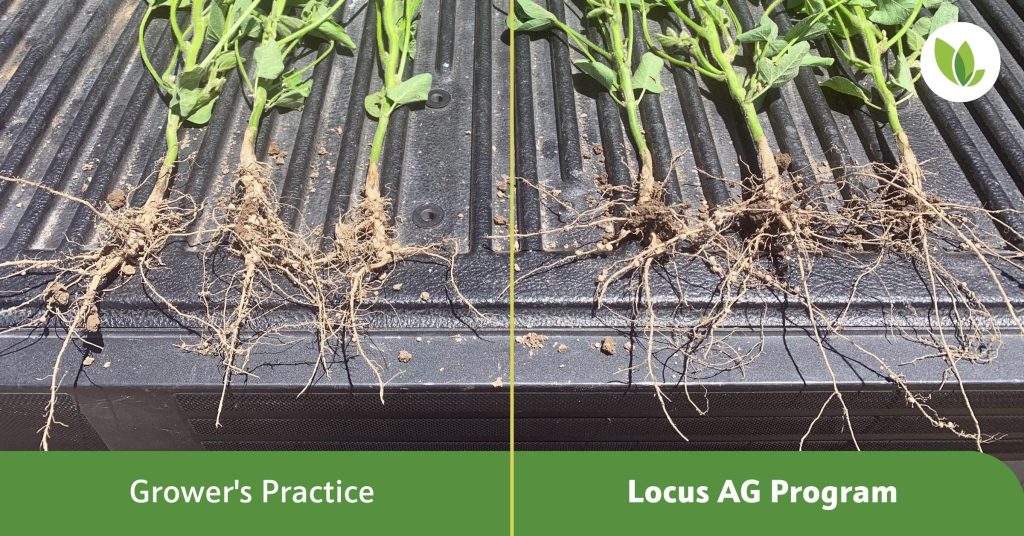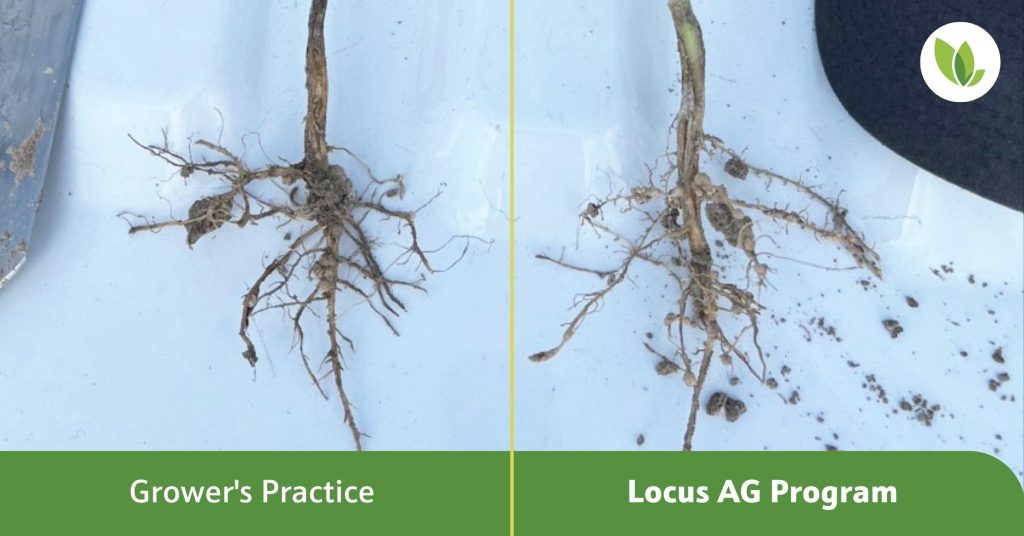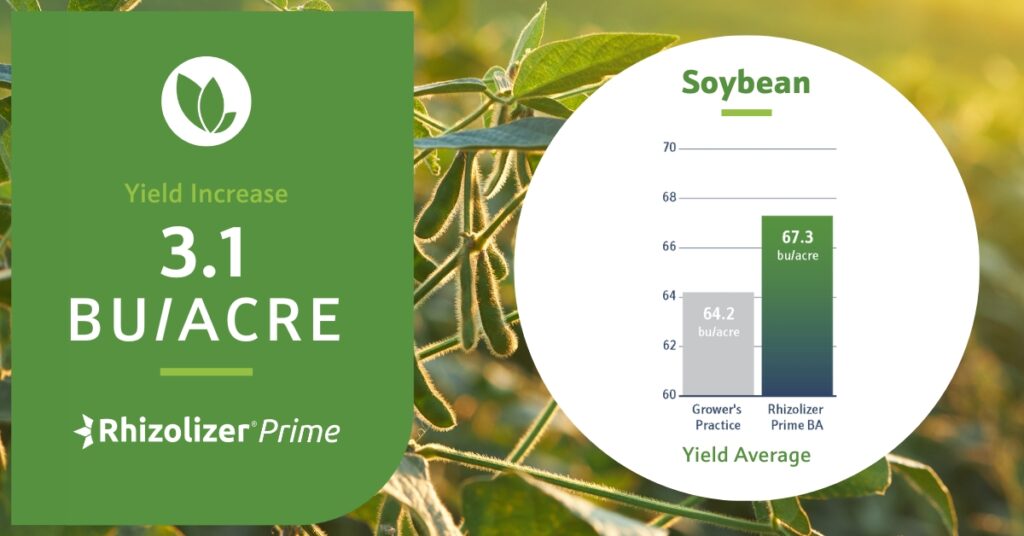
The Importance of Root Growth in Soybeans
How to maximize robust root development in soybean crops
Though they’re not always thought of as one, soybeans are a root crop. Just like with any root crop, the bigger the soybean root system, the bigger the yield. Strong root systems are essential to generating high quality soybeans, and certain biologicals can aid in root development by supplying nitrogen to soybean crops throughout the life cycle. As an addition to the crop management plan, these biologicals can support soybean root growth for greater productivity and ROI.
Read on to learn:
- How Do Soybean Root Systems Grow?
- What Does Root Growth Mean for the Success of Soybeans?
- What Is the Purpose of Nodules on Soybean Roots?
- How Can Biologicals Support Robust Soybean Root Growth?
How Do Soybean Root Systems Grow?
The soybean root system has three distinct components: the primary root (also known as taproot) that originates from a germinating seed, the lateral roots (or secondary roots) that emerge from the taproot, and the tertiary roots that originate from lateral roots.
For soybeans, plant emergence occurs between 3 to 18 days – this is when the cotyledons break the surface of the soil and are exposed to sunlight. The lateral roots then begin to grow from the primary root, and root hairs begin emergence to provide the key nutrient and water absorption functions for the plant.
Soybean taproots continue to grow and branch so that lateral roots can reach the center of a 30-inch row within five to six weeks. Under favorable conditions, soybean roots typically reach a depth of 4 to 8 feet, with the majority of roots in the upper 6 to 12 inches of soil. The rooting depth attained by a soybean root system is dependent on a variety of factors, such as soil texture, moisture, temperature, tillage, and planting date.

Soybean plants in Martinsville, IL. Plants treated with Locus AG biologicals show significantly more feeder roots and nodules, which leads to increased yields.
What Does Root Growth Mean for the Success of Soybeans?
Soybeans require strong root systems to maximize their water use and gather more nutrients, including the macronutrients N-P-K (nitrogen, phosphorus, potassium), as well as important micronutrients.
Two main types of roots play a central role to the successful growth of soybean crops:
- The deep, vertical roots drive downwards, allowing soybeans to access the water in deeper soil layers.
- Shallow, lateral roots branch outwards, increasing the nutrient absorption capacity from the surface area in topsoil.
Soybeans need both strong vertical and lateral roots to maximize their water and nutrient uptake efficiency—particularly for nitrogen. Soybeans have a uniquely high demand for nitrogen. Well-developed root systems enable soybeans to take in more nitrogen and other crucial nutrients. The stronger the soybean root system, the greater the resilience in times of limited resource availability.
What Is the Purpose of Nodules on Soybean Roots?
Soybean plants require such a large amount of Nitrogen for growth. Luckily, agronomists have uncovered a unique way to reduce the need for heavy N inputs to meet those requirements. The soybean plant, and a few other species of legumes, can create up to 50% to 90% of their required Nitrogen through a symbiotic relationship with the bacteria Rhizobium. The bacteria and plant benefit each other:
- The bacterium create a structure called a nodule on the roots that convert atmospheric nitrogen to a form that is usable by the plant.
- The soybean plants provide the bacterium with a home and energy source needed for continued fixation.
Farmers can buy seed with an inoculant treatment added to the seed, or the inoculant can come from other sources, such as biologicals.
READ MORE: The Power of Combining Microbial Inoculants + Biologicals

Soybean plant grown using Locus AG biologicals. Treated soybean plant shows more feeder roots and nodules, which leads to more nutrient uptake by the plant.
How Can Biologicals Support Robust Soybean Root Growth?
Biologicals that can stimulate root growth, improve nutrient uptake, and impact nodule formation can help crops overcome the nutrient deficiencies often seen in soybean production.
Locus AG’s Rhizolizer Prime contains three types of microbes:
- Trichoderma virens
- Bacillus amyloliquefaciens
- Bradyrhizobia japonicum
Each of these microbes are endophytic, meaning that they enter the plant at time zero—when the seed germinates—and live inside the plant to help it process vital nutrients.
This combination of microbes increases the plant’s root mass, vegetative growth, yield, and overall vitality.

In third-party CRO trials, Locus AG’s Rhizolizer Prime biologicals increased soybean yields by an average of 3.1 bu per acre, compared to the yields from standard growers’ practice—a 5% increase over grower’s practice!
These trial results are considered Statistically Significant, meaning that there is a 95% confidence level that the results we’re seeing in our trials will occur in farmer fields. These trials occurred over 14 individual trials at 12 CRO locations. Trials are independent, and randomized and replicated four times.
Rhizolizer Prime shows a great yield response even in corn/soybean rotation. This is important because growers can see a great increase with inoculated seed when they plant into soil that has not seen soybean for a while.
Locus AG biologicals are produced in the USA, available for immediate shipment, and are supplied through many major agricultural distributors and retailers.
SUMMARY
It’s time to invest in products that are proven to enhance nutrient availability and productivity, and maximize the potential of your soybean crops. Contact your regional Locus AG sales rep to get started.
Want to learn how Locus AG vital biologicals can increase your yields and profits?
Fill out the form below and one of our agricultural experts will be in touch.



